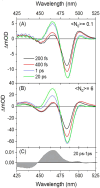Spectator Exciton Effects in Nanocrystals III: Unveiling the Stimulated Emission Cross Section in Quantum Confined CsPbBr3 Nanocrystals
- PMID: 39007415
- PMCID: PMC11273341
- DOI: 10.1021/jacs.4c05412
Spectator Exciton Effects in Nanocrystals III: Unveiling the Stimulated Emission Cross Section in Quantum Confined CsPbBr3 Nanocrystals
Abstract
Quantifying stimulated emission in semiconductor nanocrystals (NCs) remains challenging due to masking of its effects on pump-probe spectra by excited state absorption and ground state bleaching signals. The absence of this defining photophysical parameter in turn impedes assignment of band edge electronic structure in many of these important fluorophores. Here we employ a generally applicable 3-pulse ultrafast spectroscopic method coined the "Spectator Exciton" (SX) approach to measure stimulated-emission efficiency in quantum confined inorganic perovskite CsPbBr3 NCs, the band edge electronic structure of which is the subject of lively ongoing debate. Our results show that in 5-6 nm CsPbBr3 NCs, a single exciton bleaches more than half of the intense band edge absorption band, while the cross section for stimulated emission from the same state is nearly 6 times weaker. Discussion of these findings in light of several recent electronic structure models for this material proves them unable to simultaneously explain both measures, proving the importance of this new input to resolving this debate. Along with femtosecond time-resolved photoluminescence measurements on the same sample, SX results also verify that biexciton interaction energy is intensely attractive with a magnitude of ∼80 meV. In light of this observation, our previous suggestion that biexciton interaction is repulsive is reassigned to hot phonon induced slowdown of carrier relaxation leading to direct Auger recombination from an excited state. The mechanism behind the extreme slowing of carrier cooling after several stages of exciton recombination remains to be determined.
Conflict of interest statement
The authors declare no competing financial interest.
Figures








Similar articles
-
Unusually Strong Biexciton Repulsion Detected in Quantum Confined CsPbBr3 Nanocrystals with Two and Three Pulse Femtosecond Spectroscopy.ACS Nano. 2021 May 25;15(5):9039-9047. doi: 10.1021/acsnano.1c02123. Epub 2021 May 11. ACS Nano. 2021. PMID: 33974397
-
Excitation Wavelength and Intensity-Dependent Multiexciton Dynamics in CsPbBr3 Nanocrystals.Nanomaterials (Basel). 2021 Feb 11;11(2):463. doi: 10.3390/nano11020463. Nanomaterials (Basel). 2021. PMID: 33670301 Free PMC article.
-
Exciton, Biexciton, and Hot Exciton Dynamics in CsPbBr3 Colloidal Nanoplatelets.J Phys Chem Lett. 2020 Jan 16;11(2):387-394. doi: 10.1021/acs.jpclett.9b03282. Epub 2019 Dec 27. J Phys Chem Lett. 2020. PMID: 31869228
-
Revealing the Exciton Fine Structure in Lead Halide Perovskite Nanocrystals.Nanomaterials (Basel). 2021 Apr 20;11(4):1058. doi: 10.3390/nano11041058. Nanomaterials (Basel). 2021. PMID: 33924196 Free PMC article. Review.
-
Carrier Multiplication Mechanisms and Competing Processes in Colloidal Semiconductor Nanostructures.Materials (Basel). 2017 Sep 18;10(9):1095. doi: 10.3390/ma10091095. Materials (Basel). 2017. PMID: 28927007 Free PMC article. Review.
Cited by
-
Ultrastable lasing from perovskite colloidal nanocrystals.Sci Adv. 2025 Jul 11;11(28):eadq9002. doi: 10.1126/sciadv.adq9002. Epub 2025 Jul 9. Sci Adv. 2025. PMID: 40632855 Free PMC article.
References
-
- Hilborn R. C. Einstein Coefficients, Cross Sections, f Values, Dipole Moments, and All That. Am. J. Phys. 1982, 50, 982–986. 10.1119/1.12937. - DOI
-
- Ashoori R. C. Electrons in artificial atoms. Nature 1996, 379 (6564), 413–419. 10.1038/379413a0. - DOI
-
- Park Y.-S.; Roh J.; Diroll B. T.; Schaller R. D.; Klimov V. I. Colloidal quantum dot lasers. Nature Reviews Materials 2021, 6 (5), 382–401. 10.1038/s41578-020-00274-9. - DOI
LinkOut - more resources
Full Text Sources

